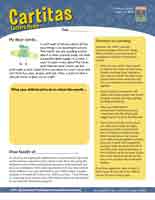• by Laurie Posner, MPA • IDRA Newsletter • March 2012 •

Updated July 2012
It is said that from the earliest hearths of the world and the first impulse toward human language, we have had stories. Grandparents, mothers, fathers and teachers pass down tales to children, who, in turn, fashion stories from their days. And that place where art meets necessity binds us across generations.
But in the formal context of the classroom, many children have been excluded in one way or another from the making and sharing of stories. U.S. government policy from the time of the Indian Peace Commission (1868) and for a century thereafter was to suppress Native American languages in Indian boarding and day schools – languages the Commissioner of Indian Affairs from 1885 to 1888 called “barbarous dialect[s]” (Reyner, 2010). By 1923, more than 30 states had passed laws mandating English-only classroom instruction (Ovando, 2003). It would not be until the mid- to late 1960s (following the federal Elementary and Secondary Education Act in 1965 and Bilingual Education Act in 1968) that most states enacted laws in support of bilingual education – or “at least decriminalizing the use” of languages other than English in public schools (Cohen, 1975 as cited in Certa & Hernandez, 2006).Still, in linguistic and socio-economic terms, a wedge had grown between formal and family education, often privileging the former at the expense of the latter. But a large and growing body of research has challenged the conventional wisdom of the school-home divide. A synthesis of 51 studies by Anne Henderson & Karen Mapp (2002) concluded that there is a consistent positive relationship between family engagement and improved academic achievement. They found that family engagement is tied to higher grades and test scores, enrollment in higher level programs, passing classes and earning course credits, better school attendance and social skills, graduation, and advancement to postsecondary education. “When schools, families and community groups work together to support learning,” the researchers found, “children tend to do better in school, stay in school longer and like school more” (2002).
Still, in linguistic and socio-economic terms, a wedge had grown between formal and family education, often privileging the former at the expense of the latter. But a large and growing body of research has challenged the conventional wisdom of the school-home divide. A synthesis of 51 studies by Anne Henderson & Karen Mapp (2002) concluded that there is a consistent positive relationship between family engagement and improved academic achievement. They found that family engagement is tied to higher grades and test scores, enrollment in higher level programs, passing classes and earning course credits, better school attendance and social skills, graduation, and advancement to postsecondary education. “When schools, families and community groups work together to support learning,” the researchers found, “children tend to do better in school, stay in school longer and like school more” (2002). These findings hold true for students of all ages and across socioeconomic, racial/ethnic, and educational backgrounds (Mapp, 2004).
Charles Payne & Mariame Kaba found that recognizing parents and community members as assets to the process of raising student achievement can predict the quality of a school (2001). Research by Eric Dearing, et al., (2006) examined the association over time between family involvement in children’s K-5 education and literacy development, finding that improvements predict increases in K-5 literacy development and have greater implications for children’s literacy than do family income, maternal level of education or child ethnicity.
Despite the finding that community and parent involvement is pivotal to school success, persistent barriers thwart the growth of meaningful school-family partnerships. These obstacles include seeing language and cultural differences as barriers (rather than as strengths) as well as deficit-based interactions that suggest to families that they either are irrelevant to student success or are the principal cause of student failure. Many teacher training programs give too little attention to preparing teachers to build vibrant partnerships with diverse families and community members.
Mariana Souto-Manning & Kevin Swick suggest that part of the fault may lie in a paradigm of parent and family involvement that “is couched in a compensating… model where particular parent attributes may be seen as deficiencies or weaknesses” (2006). Although some ground has been gained in overcoming barriers and paradigms that have proved to be unworkable, the full possibilities of family-school partnership remain untapped.
In the area of early childhood, IDRA has developed its Semillitas de aprendizaje™ bilingual supplemental curricula and materials to build on what is working and help address this gap. Semillitas de aprendizaje, which includes richly illustrated big books and small math and self concept readers that foster literacy and numeracy in young children, is grounded in research and 30 years of field experience in creating dynamic early learning environments for English language learners. The new Cartitas or “letters home” series is designed as a companion piece to these books – fostering school-family partnerships around storybooks that speak to children.
Why “Letters Home”


Each of the 20 Cartitas (10 English, 10 Spanish) is organized around themes and activities that arise from the bilingual big book stories and small math and self-concept books (García & Rodríguez, 2011) and is designed for early childhood educators to send home to families.
Centered on the power of the stories, the intent of Cartitas is multifold: to share with families how their children are progressing in class; to offer practical, shared school-home activities that nurture children’s development, literacy and numeracy; and to open a channel of communication that values the language, culture and contribution of families, teachers and children.








Each gold and blue letter for home is illustrated with children’s artwork and drawings from the story. At heart, the letter is meant to open a school-home dialogue, centered on shared stories, mutual respect, and each child’s growth and learning.
Resources
Dearing, E., & H. Kreider, S. Simpkins, H.B. Weiss. “Family Involvement in School and Low-Income Children’s Literacy Performance: Longitudinal Associations Between and Within Families,”
Journal of Educational Psychology (American Psychological Association, 2006) 98, 653-664.
García, J.C., & R.G. Rodríguez. “Using Semillitas de aprendizaje™ in the Early Childhood Classroom,” IDRA Newsletter (San Antonio, Texas: Intercultural Development Research Association, April 2011).
Halgunseth, L.C., & A. Peterson, D.R. Stark, S. Moodie. Family Engagement, Diverse Families, and Early Childhood Education Programs: An Integrated Review of the Literature (Washington, D.C.: NAEYC and Pre-K Now, 2009)
Henderson, A.T., & K.L. Mapp. A New Wave of Evidence: The Impact of School, Family, and Community Connections on Student Achievement (Austin, Texas: Southwest Educational Development Laboratory, 2002).
Mapp, K. “Family Engagement,” In F.P. Schargel & J. Smink (Eds), Helping Students Graduate: A Strategic Approach to Dropout Prevention (Larchmont, N.Y.: Eye on Education, 2004) pp. 99-113.
Payne, C.M., & M. Kaba. “So Much Reform, So Little Change: Building-Level Obstacles to Urban School Reform,” Journal of Negro Education (2001).
Rodríguez, R.G., & J.C. García, A. Villarreal. Community Engagement Series for Educators (San Antonio, Texas: Intercultural Development Research Association, 2011).
Souto-Manning, M., & K.J. Swick. “Teachers’ Beliefs about Parent and Family Involvement: Rethinking our Family Involvement Paradigm,” Early Childhood Education Journal (2006) 34 (2), 187-193.
Villarreal, A., & R.G. Rodríguez, B. Scott. “Responding to the Need for Bilingual Early Childhood Education Literacy Development Semillitas de Aprendizaje New Curriculum in Development,” IDRA Newsletter (San Antonio, Texas: Intercultural Development Research Association, 2008).
Laurie Posner, M.P.A., is a senior education associate in IDRA Support Services. Comments and questions may be directed to her via e-mail feedback@idra.org.
[©2012, IDRA. This article originally appeared in the March 2012 IDRA Newsletter by the Intercultural Development Research Association. Permission to reproduce this article is granted provided the article is reprinted in its entirety and proper credit is given to IDRA and the author.]


